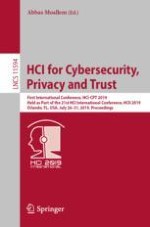2019 | Buch
HCI for Cybersecurity, Privacy and Trust
First International Conference, HCI-CPT 2019, Held as Part of the 21st HCI International Conference, HCII 2019, Orlando, FL, USA, July 26–31, 2019, Proceedings
herausgegeben von: Abbas Moallem
Verlag: Springer International Publishing
Buchreihe : Lecture Notes in Computer Science
